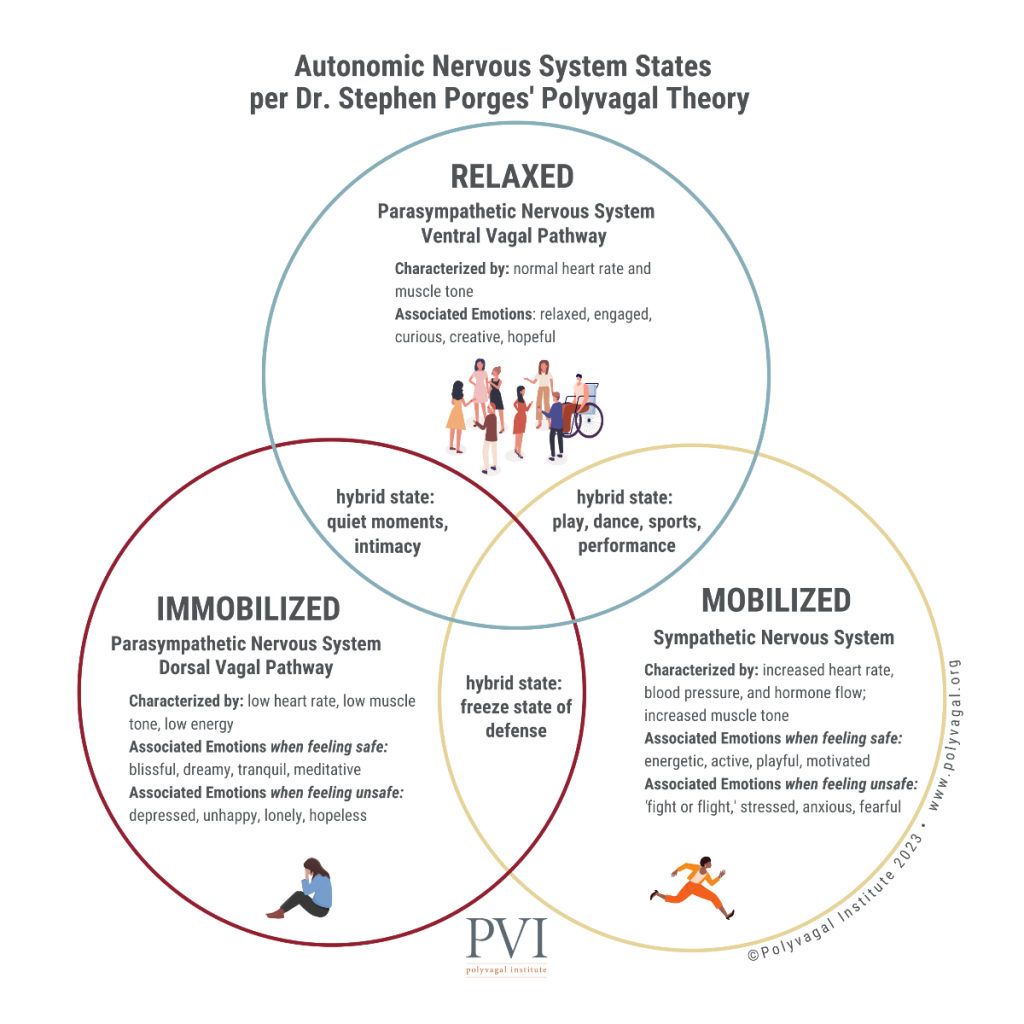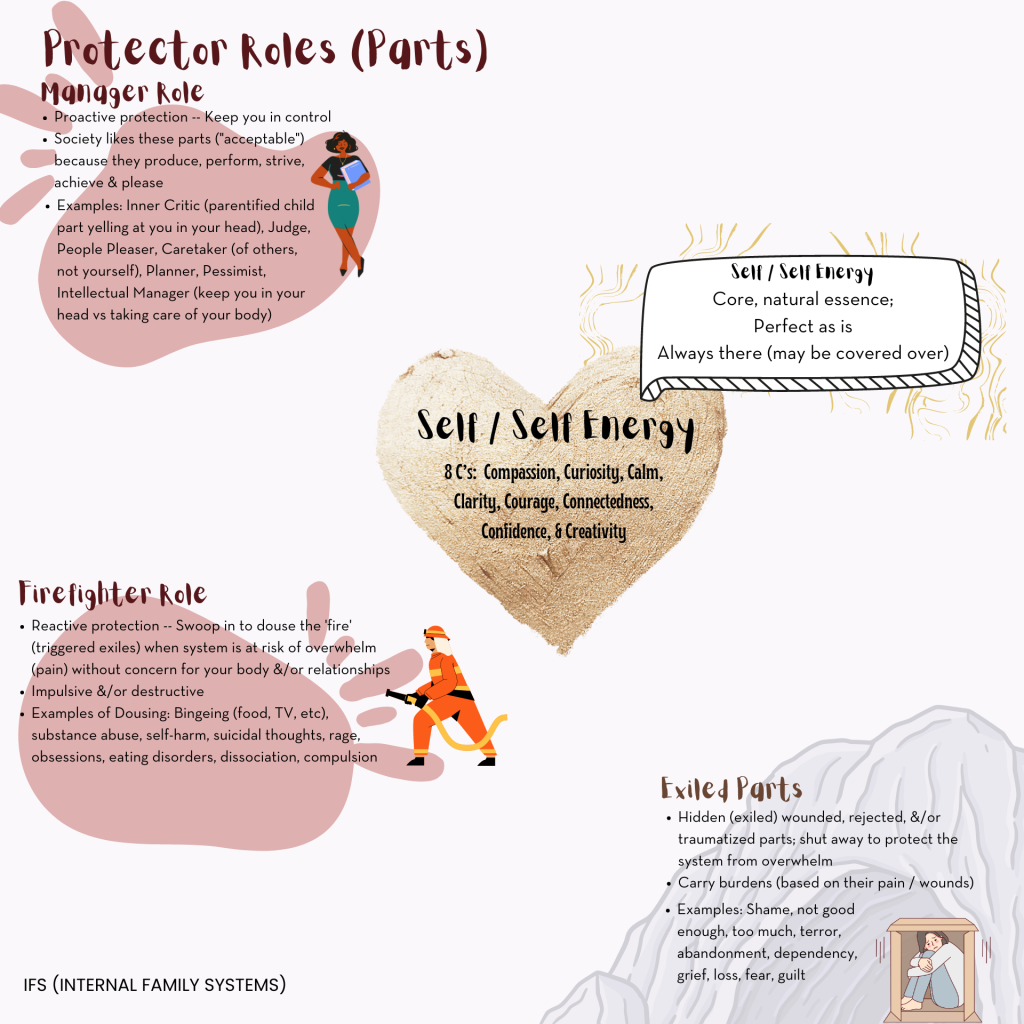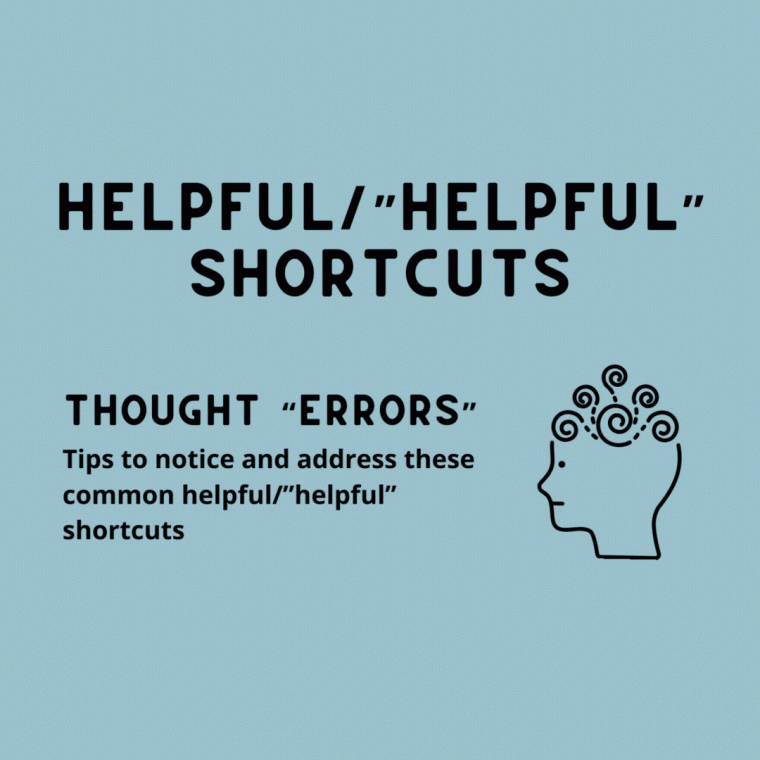We’ve all experienced those moments where our thoughts seem to be working against us. Cognitive Behavioral Therapy (CBT) often categorizes these as ‘thought errors’ or ‘cognitive distortions.’ But what if these so-called ‘errors’ are actually your mind’s helpful attempts to navigate the complexities of life? Indeed that’s the case. These thought “errors” are merely thought shortcuts. They serve a purpose, even if they sometimes mislead us. Cognitive Behavioral Therapy (CBT) has long been a go-to method for exploring how thoughts, feelings, and behaviors are interconnected. According to CBT theory, there are three primary levels of cognition: (1) negative automatic thoughts that involuntarily pop up in response to certain situations, (2) dysfunctional or intermediate assumptions, which serve as our “rules for living” and protect us from confronting deeper core beliefs, and (3) and core beliefs (or schemas), which are deeply held convictions about ourselves, others, and the future. While CBT provides valuable insights, it’s not a one-size-fits-all solution. This blog post will focus on item (1), the thought shortcuts most people employ, because most brains helpfully/”helpfully” take these same shortcuts. For the other two kinds listed, those are (a) more personal and (b) more likely than not be akin to cleaning Mt Everest with a toothbrush, should you try to address them from the top-down (meaning: via thinking your way to a shift).
But First… Some PG-13 Silliness (Blooper)
The Helpful Intent of CBT Thought Errors
While it’s easy to label these thought patterns as ‘errors,’ they are, in essence, mental shortcuts designed to help us quickly process information and make decisions. They come from our brain’s innate desire to simplify the world around us. So, rather than viewing them as mistakes, think of them as a well-intentioned, albeit sometimes misguided, approach to problem-solving and energy conservation.
Here is an excellent quote from Hershey H Friedman’s paper, Overcoming Cognitive Distortions: How to Recognize and Challenge the Thinking Traps that Make You Miserable:
But why do we use heuristics in the first place? Benson (2022) says that heuristics help us deal with four challenges: (1) we have too much information to process, (2) we do not have enough meaning to make sense of the information, (3) we have limited time and resources to act, and (4) we have limited memory to store the information. Heick (2019) also groups cognitive biases into four types based on these challenges: Too Much Information, Not Enough Meaning, Need to Act Fast, and What Should We Remember?
Even though these thought shortcuts have a helpful intent, they can sometimes lead us into emotional pitfalls. For instance, black-and-white thinking might be a quick way to categorize situations but can rob us of the nuances that come with emotional intelligence. (Black and white thinking is also known as “all-or-nothing thinking,” is a mental shortcut that categorizes situations into extremes, lacking nuance and middle ground.)
Common Thinking Shortcuts:
Here’s a list of common CBT thought errors (heuristics).
- Overgeneralization – Drawing broad conclusions based on a single event or piece of evidence.
- Catastrophizing – Anticipating the worst possible outcome in a situation, often leading to heightened stress and anxiety.
- Personalization – Taking things too personally or blaming yourself for events that are not entirely under your control.
- Mental Filtering – Focusing solely on the negative aspects of a situation, while ignoring the positive.
- Jumping to Conclusions – Making assumptions without sufficient evidence, including “mind-reading” (assuming you know what others are thinking) and “fortune-telling” (predicting events will turn out badly).
- Should Statements – Holding rigid expectations of yourself or others, leading to frustration and disappointment.
- Emotional Reasoning – Believing that because you feel a certain way, it must be true. For example, feeling stupid and therefore believing you are stupid.
- Labeling – Assigning labels to yourself or others based on a single event or behavior.
- Disqualifying the Positive – Dismissing positive experiences as flukes or not important.
- Blaming – Holding others entirely responsible for your emotional state or life circumstances.
Tips
When you spot a thought error, here are some things you can try. Note that you can use Havening Touch with most, if not all of these. To learn about Havening Touch and find out the areas to touch, click here.
Black and White Thinking (All or Nothing)
Advice: Recognize that most things in life exist on a spectrum. Try to identify some middle-ground options or shades of gray.
Overgeneralization
Advice: Catch yourself when making sweeping statements like “always” or “never.” Challenge this by recalling specific instances that contradict the generalization.
Catastrophizing
Advice: Ground yourself in the present moment. Use deep breathing or sensory techniques to reduce immediate stress and then ask, “What’s the most likely outcome?”
Personalization
Advice: Take a step back and list other factors that could have contributed to the situation. Remember, you’re not the center of every narrative.
Mental Filtering
Advice: Make a balanced list of both positive and negative aspects of the situation. Sometimes your brain needs a little nudge to see the full picture.
Jumping to Conclusions
- Mind-reading: Validate your assumptions by open communication rather than assuming you know what others are thinking.
- Fortune-telling: Test your hypothesis. Ask yourself what evidence you have for and against your predicted outcome.
Should Statements
Advice: Shift from “should” to “could.” This turns obligations into choices, giving you a sense of control and reducing frustration.
Emotional Reasoning
Advice: Acknowledge the emotion without judgment and then investigate it. Emotions are indicators, not dictators.
Labeling
Advice: Identify the behavior or event that led to the label and focus on that instead. Labels are not whole truths.
Disqualifying the Positive
Advice: Keep a gratitude journal or a ‘win’ diary. It’s harder to discount the positive when it’s there in black and white.
Blaming
Advice: While it’s easier to point fingers, accountability gives you the power to change your situation. Ask what part you play in your emotional state or circumstances.
Remember, these mental shortcuts have a helpful intent, like speeding up decision-making or protecting you from perceived threats. These (above) are generally considered as some of the “cognitive distortions” or “thought errors” (mental shortcuts) that many people’s brains default to. These heuristics are not “flaws” but rather reflect the brain’s adaptive strategies to manage information efficiently. However, the trade-off is that they can sometimes lead to misjudgments or reinforce unhelpful emotional patterns. So, while these shortcuts are common to the human experience, their impact can vary from person to person, especially if they become overly relied upon or are linked to deeper emotional or physiological responses.
When CBT Isn’t Cutting It
If you find yourself stuck despite knowing your thought errors and attempting to reframe them, it might be a sign that there’s more going on beneath the surface. This is where other approaches like polyvagal theory, IFS, and havening techniques come into play.
Polyvagal Theory: Tuning Into Your Body
Polyvagal theory helps you understand your body’s physiological response to stress and trauma. It emphasizes the importance of feeling safe and connected, encouraging a ‘bottom-up’ approach to emotional well-being. More specifically, we are looking at what is going on behind-the-scenes as our nervous system employs neuroception, it’s constant scan for cues of threat and safety. This can be particularly useful if you find that your thought errors are deeply entwined with physical sensations or past traumas. Here’s an illustration for the Polyvagal Institute:

My other fave is this PDF.
I also post a lot on polyvagal theory… turning it into a fun “Feather-O-Meter.”

Internal Family Systems (IFS): Meeting Your Parts
IFS offers a framework to explore the different ‘parts’ of yourself, understanding that each has its own role and intention. (There are no bad parts: Parts always have a helpful intent.) If you notice a recurring thought pattern that isn’t all that helpful, there might be a specific ‘part’ driving that thought pattern. IFS allows you to connect with that part, understanding its helpful intent and negotiating healthier patterns. I have posted a lot about IFS on this blog. Here is a visual overview:

Havening Techniques: Realigning Emotional Responses
Havening Techniques aim to ‘depotentiate’ traumatic memories, essentially lessening their emotional charge. We are literally uninstalling threat-based encodings:

You can learn more about Havening here.
How can you know it’s time to try something other than CBT? Here are some possible clues:
- Intense Emotions: If the thought pattern triggers disproportionate emotional responses, it might be rooted in a deeper issue.
- Persistent Patterns: When the thought shortcut keeps recurring despite conscious efforts to reframe or challenge it.
- Physical Sensations: Havening Techniques’s C.A.S.E. (Cognitive, Autonomic, Somatosensory, Emotions) concept can come in handy. If the thought pattern is part of a bigger C.A.S.E. or if it triggers specific bodily sensations like muscle tension, rapid heartbeat, or shallow breathing, that’s a signal to look deeper.
- Unyielding to CBT: Some people find that even after identifying their cognitive distortions and trying to reframe them, the distortions persist. This resistance might indicate a deeper emotional or physiological issue.
- Triggers: If seemingly unrelated events or situations trigger the thought pattern, this could indicate that it’s a symptom of a broader issue.
- Impacts Daily Life: When the thought pattern starts to negatively impact daily functioning, relationships, or work.
- Avoidance Behavior: If the thought pattern leads you to consistently avoid certain situations or experiences, this could be a sign of a deeper issue.
- Thought Pattern Not on The (or Any) CBT List: Not all deeply-rooted issues will neatly fit into the common list of CBT thought errors. Some may be unique to your experience, and if they persist, may require deeper exploration.
- Contradicts Reality: If you find yourself holding onto a cognitive distortion despite clear evidence to the contrary, it might be anchored in deeper emotional or experiential layers.
- Isolation or Disconnection: If you find the thought pattern leads you to isolate yourself or disconnect from your support systems.
Recap
While CBT’s approach to thought errors offers valuable insights, it’s crucial to remember that these mental shortcuts come from a place of helpful intent. If you find that reframing these thought patterns isn’t doing the trick, don’t hesitate to explore more body-based and trauma-informed therapies. Polyvagal theory, IFS, and havening techniques provide comprehensive avenues for digging deeper, allowing you to address the emotional and physiological roots of your reactions. Remember, your emotional toolkit can be as diverse as you are. Keep exploring, and stay curious!
